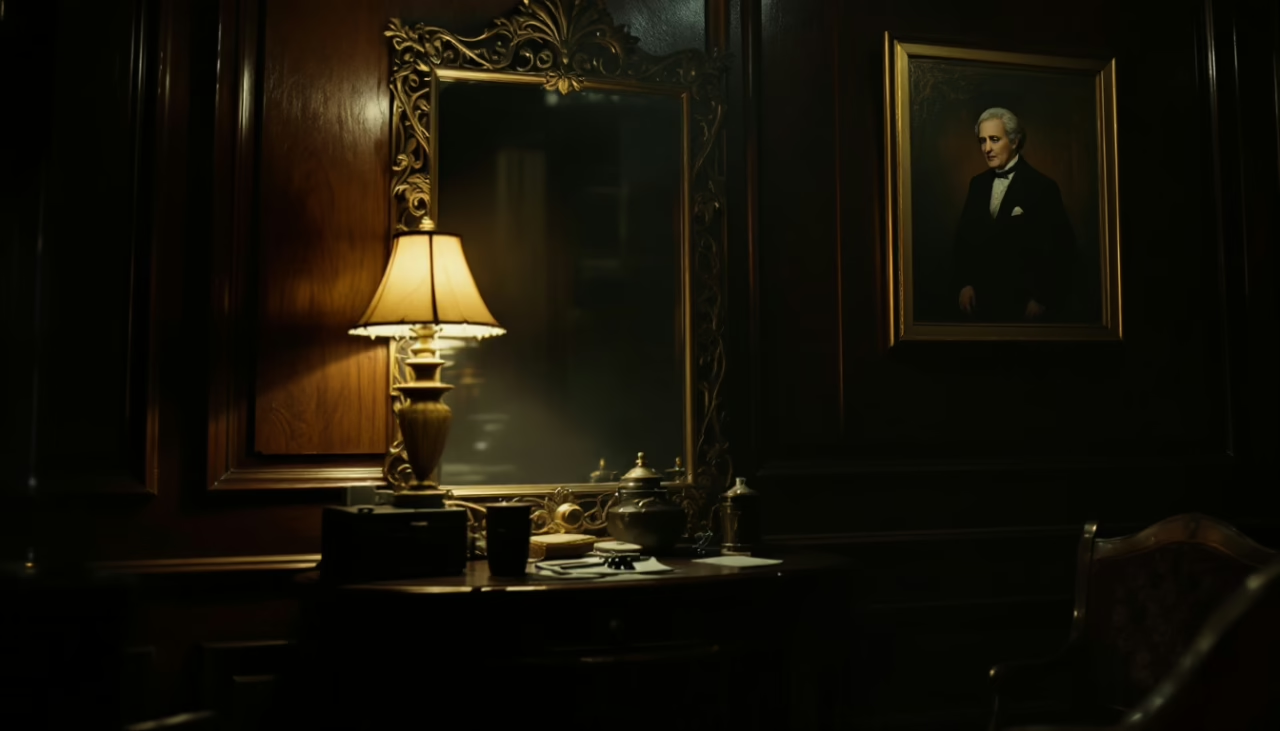The Vanishing of Agatha Christie: A Mystery

In December 1926, Agatha Christie vanished without explanation. The celebrated author’s empty car near a chalk quarry sparked national alarm, transforming a personal crisis into public spectacle.
Theories multiplied like characters in her mysteries—suicide, amnesia, publicity stunt, or murder. For eleven days, England held its breath while newspapers chronicled every development with fevered speculation.
What truly happened during Christie’s disappearance?
The answer remains tantalizingly obscure, a real-life puzzle crafted by the very woman who mastered the art of literary suspense.
Key Takeaways
Hide- Agatha Christie disappeared for eleven days in December 1926, abandoning her car near a chalk quarry and sparking a nationwide manhunt.
- Despite extensive police searches involving over 1,000 officers and bloodhounds, Christie was eventually found at a hotel in Harrogate using a pseudonym.
- Medical experts attributed her disappearance to a psychological fugue state triggered by her mother's death and husband's infidelity.
- Christie never publicly explained her disappearance, leaving the event shrouded in mystery that continues to fascinate scholars and fans.
- The vanishing occurred during a personal crisis involving marital troubles, creating persistent theories about whether it was deliberate or psychologically induced.
Setting the Stage: Agatha Christie’s Life and Legacy

By the early 1920s, Agatha Christie had ascended to literary fame with her ingenious murder mysteries, establishing herself as the preeminent voice in detective fiction whose intricate plots and memorable characters captivated millions worldwide.
Her public success, however, stood in stark contrast to her private tribulations—a failed first marriage, periods of depression, and the relentless pressure of maintaining her prolific output under the unforgiving spotlight of celebrity.
These tensions between Christie’s brilliant literary mind and her personal vulnerabilities would ultimately converge in December 1926, setting the stage for one of the most perplexing disappearances in literary history.
Her Rise as the Queen of Mystery
Agatha Christie’s ascent to literary stardom, marked by an unparalleled succession of bestselling detective novels that captivated audiences across continents, established her firmly as the undisputed Queen of Mystery by the mid-twentieth century.
Behind the phenomenal sales figures and critical acclaim lay a woman who strategically cultivated an enigmatic public persona, offering readers just enough personal glimpses to satisfy curiosity while maintaining the mysterious aura that complemented her fiction.
This deliberate balance between revelation and concealment created a symbiotic relationship between Christie’s carefully constructed public image and her fictional worlds of murder and deception, enhancing the mystique that would make her disappearance all the more sensational.
Global fame from bestselling detective novels
Through the publication of her first novel, “The Mysterious Affair at Styles,” in 1920, Christie ignited what would become one of literature’s most remarkable ascents to global fame.
Her ingenious plotting and accessible prose transcended cultural boundaries, enchanting readers across continents with translations in over 100 languages, a proof of mystery’s universal appeal.
- The enduring allure of Hercule Poirot’s “little gray cells”
- Freedom to explore human psychology through murder
- Intellectual liberation through puzzle-solving narratives
- The thrill of justice served in diverse, exotic settings
Crafting an enigmatic public persona
While Christie’s novels garnered international acclaim, the author herself remained deliberately shrouded in mystery, a paradoxical figure whose reluctance to step into the limelight only heightened public fascination.
She cultivated this elusive persona through calculated public appearances, rare interviews, and the strategic withholding of personal details—creating a vacuum that readers enthusiastically filled with speculation and wonder about the mind behind literature’s most ingenious puzzles.
The Burden of Celebrity and Personal Struggles
Behind Christie’s meteoric rise to literary fame lurked a shadow world of personal torment, hidden from her adoring public yet profoundly shaping her inner landscape.
Fame’s persistent demands eroded her carefully constructed boundaries, forcing her to navigate an increasingly complex relationship between her public persona and private identity.
The mounting pressure of celebrity, coupled with devastating personal losses and the dissolution of her first marriage, created a perfect storm of mental and emotional exhaustion that would ultimately push the celebrated author to a breaking point.
Challenges with fame and private life
Agatha Christie seldom spoke publicly about the suffocating weight of fame that descended upon her as she became the world’s best-selling novelist.
Her private correspondence, however, revealed a woman increasingly burdened by her literary success, struggling to maintain autonomy in a world that claimed ownership of her persona.
- Journalists camped outside her properties, monitoring her movements
- Family gatherings became fodder for tabloid speculation
- Public appearances drained her introverted nature
- Freedom to write undisturbed became her most cherished, elusive desire
Pressures and mental fatigue leading to turmoil
Exhaustion, both mental and spiritual, descended upon Christie by the winter of 1926, transforming her once-ordered existence into a landscape of increasing psychological fragility.
The crushing weight of literary deadlines coincided with her mother’s death and her husband’s affair, creating a perfect storm of emotional distress.
Christie’s correspondence revealed a woman caught between public demands and private anguish, desperately seeking escape from expectations that threatened to consume her identity.
The Mysterious Disappearance of 1926
On the chilly evening of December 3, 1926, Agatha Christie kissed her sleeping daughter goodnight, left a cryptic note for her secretary, and vanished into the winter darkness, setting in motion one of the most perplexing mysteries of the twentieth century.
Her abandoned Morris Cowley was discovered the following morning teetering on the edge of a chalk quarry at Newlands Corner, igniting unprecedented media frenzy as newspaper headlines screamed speculation of murder, suicide, or calculated publicity stunt.
The British public, captivated by the real-life disappearance of their beloved mystery writer, joined over a thousand officers and countless bloodhounds in a massive manhunt that transformed Christie’s personal crisis into a national obsession.
Timeline of the Vanishing
The final reported sightings of Agatha Christie before her mysterious eleven-day disappearance place her at the Newlands Corner Hotel in Berkshire on December 3, 1926, where multiple staff members recalled seeing the celebrated author in varying states of distress.
Eyewitness testimonies from the hotel remain frustratingly contradictory, with some claiming she appeared perfectly composed while others described her as “ghost-like” and disoriented, creating a fractured narrative that historians have struggled to reconcile for nearly a century.
The dearth of official documentation from this critical period—no hotel register has survived, and police records remain incomplete—has only deepened the enigma surrounding those pivotal hours before Christie vanished into the winter night, leaving behind only her abandoned Morris Cowley automobile, headlights still burning, perched precariously on a slope near the Surrey Downs.
Last known sightings in a Berkshire hotel
Before vanishing into the crisp December night, Agatha Christie was last observed by multiple witnesses at the Newlands Corner Hotel in Berkshire on the evening of December 3, 1926.
Her ghostly departure from public view sparked an unprecedented manhunt across England.
- A chambermaid noticed Christie’s distant, contemplative gaze at dinner
- Her abandoned vehicle discovered near Surrey’s Newlands Corner the following morning
- A peculiar letter addressed to her secretary remained in her hotel room
- Only a small valise missing, though she packed extensively for her stay
Conflicting eyewitness accounts and sparse documentation
Despite extensive investigation following her disappearance, Christie’s movements during those eleven missing days remain shrouded in contradiction and evidentiary gaps, with testimonies fracturing like pieces of an unsolvable puzzle.
Hotel staff reported conflicting sightings—some claiming she appeared distressed, others describing her as oddly serene—while the sole documented evidence, a cryptic entry in the guest register, provides tantalizingly insufficient clarity regarding her psychological state.
Immediate Public and Media Reaction
Agatha Christie’s abrupt disappearance in December 1926 catalyzed an unprecedented media frenzy, with newspapers across Britain splashing sensational headlines that questioned whether the author had met with foul play, committed suicide, or orchestrated an elaborate publicity stunt.
The Metropolitan Police, faced with mounting public pressure and tabloid speculation, mobilized significant resources—including the first recorded use of airplanes in a missing person search—to scour the Surrey countryside where Christie’s abandoned Morris Cowley had been discovered.
Despite meticulous police reports documenting every lead, from purported sightings to suspicious footprints near Newlands Corner, the public’s imagination raced far ahead of official findings, transforming a personal crisis into a national obsession that captivated readers from London to New York.
Sensational headlines and widespread speculation
Hysteria gripped the British public when news of Christie’s disappearance broke in December 1926, transforming what might have been a private family matter into the most sensational missing person case of the era.
Newspapers disseminated theories ranging from murder to publicity stunts, stoking public intrigue daily.
- Headlines speculating foul play by her husband
- Dramatized accounts of possible suicide
- Reported “sightings” across England
- Rumors of amnesia or mental breakdown
Official investigations and police reports
The enormous police operation launched to locate Agatha Christie began within hours of her abandoned car’s discovery near the Silent Pool in Surrey, mobilizing resources on an unprecedented scale for a missing person case.
Over 1,000 officers combed the countryside while bloodhounds traversed rugged terrain.
Police reports, now preserved in national archives, reveal meticulous methodology in searching ponds, interviewing witnesses, and investigating potential motives behind her disappearance.
Exploring Theories Behind the Disappearance
Competing theories about Christie’s eleven-day disappearance have emerged over decades, ranging from psychological explanations centered on dissociative fugue triggered by marital distress and her mother’s death to more elaborate conspiracy narratives.
Some scholars have proposed that Christie’s vanishing act was a calculated response to emotional trauma, a temporary escape from unbearable reality rather than a publicity stunt as initially suggested by skeptical press.
The more fantastical theories involving espionage work or secret government missions, while intriguing to imagination, remain largely unsupported by historical evidence despite Christie’s later work with British intelligence during World War II.
Psychological Explanations
Medical experts have proposed that Christie may have experienced a fugue state during her disappearance, a rare psychological condition characterized by temporary amnesia and identity confusion, potentially triggered by the emotional trauma of her husband’s infidelity.
The pressure of her growing literary fame, which had thrust the once-private author into the unforgiving spotlight of public scrutiny, might have intensified her desire to temporarily vanish from her own life.
Christie’s disappearance could represent an unconscious escape mechanism, a psychological withdrawal from overwhelming circumstances that manifested as a physical disappearance – a theory supported by her disoriented state upon discovery and her lifelong reluctance to discuss the incident.
Potential amnesia or identity crisis
Why would a successful, intelligent author suddenly forget her own identity?
Psychologists have proposed that Christie may have experienced dissociative amnesia, a condition triggered by extreme stress and emotional trauma. Her cognitive faculties, under tremendous strain from her husband’s infidelity and her mother’s death, potentially fractured in a defensive psychological maneuver.
- The mind, seeking escape from unbearable reality, crafts its own liberation
- Memory, typically our anchor to self, becomes the very chain that must be broken
- Identity dissolves when continuity of self becomes too painful to maintain
- Freedom sometimes requires forgetting who we are to discover who we might become
Desire to escape overwhelming public attention
Another explanation for Christie’s mysterious disappearance lies in the relentless spotlight that had begun to illuminate every corner of her life.
The newly-famous author, thrust into celebrity status after her early literary successes, may have craved anonymity—a temporary reprieve from journalists, photographers, and public expectations.
Perhaps Christie, feeling suffocated by fame’s unexpected constraints, orchestrated her own liberation through disappearance.
Conspiracy and Espionage Theories
The disappearance of Agatha Christie spawned numerous conspiracy theories, including whispers that British intelligence had recruited the novelist for a clandestine mission during her eleven-day absence.
National newspapers, hungry for sensational headlines during the extensive manhunt, published increasingly outlandish explanations that transformed a personal crisis into potential international intrigue.
These alternative narratives, though lacking substantive evidence, reveal how readily the public embraced elaborate espionage scenarios rather than accepting the more mundane psychological explanations for Christie’s temporary vanishing from public life.
Rumors of secret government involvement
Among the most persistent theories surrounding Agatha Christie’s disappearance lurks the shadow of government involvement, a notion that has captivated conspiracy theorists for decades.
Historians remain skeptical, yet the intrigue endures in whispered conversations among those who question official narratives.
- MI5 recruitment allegations suggesting Christie was being groomed for intelligence work
- Mysterious government vehicles reportedly seen near Newlands Corner
- Classified documents allegedly “missing” from the investigation files
- Unexplained gaps in surveillance at key transportation hubs during her absence
Media sensationalism fueling alternative narratives
Media sensationalism played a pivotal role in transforming Christie’s disappearance from a personal mystery into a nationwide obsession.
Newspaper editors recognized the perfect storm of public curiosity, celebrity status, and inexplicable circumstances.
Headlines blaring speculations of foul play, suicide, or amnesia circulated widely, while investigative reporters, driven by circulation demands rather than factual integrity, wove tantalizing narratives that captivated readers across Britain.
Legacy of the Unsolved Mystery
Christie’s eleven-day disappearance in 1926 cast a permanent shadow across her literary reputation, transforming her from merely a successful author into an enigmatic figure whose life rivaled her fictional mysteries for intrigue.
Scholars continue to examine this biographical puzzle through new psychological frameworks and recently discovered personal correspondence, weighing each theory against the complex backdrop of her deteriorating marriage and professional pressures.
The persistent fascination with her vanishing—evident in documentaries, biographies, and fictional retellings—reflects our cultural obsession with unsolved mysteries involving public figures and demonstrates how a single unexplained episode can permanently alter the narrative of an individual’s life.
How the Disappearance Shaped Her Image
Christie’s eleven-day disappearance, shrouded in mystery and speculation, transformed her from merely a popular author into a living embodiment of her own enigmatic narratives.
The incident crystallized her public persona as the mistress of mystery, merging her biography with her bibliography in the cultural imagination and creating an indelible association between the woman and her work.
This mythologizing effect, paradoxically unwanted by Christie herself, endowed her detective fiction with an added dimension of authenticity and intrigue that continues to captivate readers and scholars alike, sustaining public fascination with both her literature and her life nearly a century after her famous vanishing act.
The mythologizing of her life and work
Though history often strips extraordinary events of their mythic quality, Agatha Christie’s eleven-day disappearance in 1926 stands as a remarkable exception, transforming from mere biographical footnote into the cornerstone of her public persona.
- The vanishing elevated her from writer to enigma, her own life rivaling her fiction.
- Her silence about the episode created an unfinished narrative others rushed to complete.
- Media fascination transformed personal trauma into public property.
- Each retelling adds layers of speculation, cementing her status as mistress of mystery.
Lasting impact on detective fiction and public intrigue
The mysterious eleven-day disappearance remains, perhaps ironically, the most enduring puzzle in a career built upon crafting perfect mysteries.
While Christie authored eighty-six detective novels, her vanishing act transformed her into a character more compelling than any fictional sleuth she created.
This biographical enigma not only cemented public fascination with Christie herself but permanently altered how readers approach her meticulously constructed literary puzzles.
Ongoing Research and Modern Reappraisals
Recent archival discoveries, including previously unpublished correspondence and hotel registers, have reignited scholarly interest in Christie’s eleven-day disappearance, prompting a wave of interdisciplinary research that applies modern psychological frameworks to the mystery.
The enigma continues to captivate academics and Christie enthusiasts alike, serving as both a biographical curiosity and a potent symbol of the author’s complex relationship with fame and narrative control.
Contemporary researchers, armed with digital archives and forensic methodologies unavailable to their predecessors, find themselves entangled in the same web of contradictions and half-truths that has preserved this literary disappearance as one of the twentieth century’s most compelling unsolved mysteries.
New scholarly investigations and archival discoveries
Decades after Agatha Christie’s mysterious eleven-day disappearance, contemporary researchers continue unearthing significant revelations that reshape our understanding of this enigmatic episode in literary history.
Recent archival discoveries, including previously unpublished correspondence and hotel records, illuminate the psychological dimensions of Christie’s fugue state.
- Newly uncovered physician notes suggesting potential dissociative amnesia
- Personal letters revealing marital distress more severe than publicly acknowledged
- Unpublished manuscript fragments potentially alluding to her own disappearance
- Forensic psychological profiles reconstructing her emotional state during those missing days
The continued allure of an unsolved literary enigma
Why, nearly a century after those eleven fateful December days, does Agatha Christie’s disappearance continue to captivate both scholarly attention and popular imagination with such unwavering intensity?
Perhaps because it represents the perfect narrative paradox: an intricate mystery crafted by the very architect of mystery itself.
Her disappearance offers that rarest of intellectual liberties—an enigma we can freely interpret, unbounded by conclusive evidence, yet rich with tantalizing clues.
Reflections on the Enigma of a Literary Icon
Agatha Christie’s enigmatic disappearance exists at the crossroads where her literary fame, her personal mysteries, and public memory converge in a tapestry that continues to captivate readers and scholars alike.
Her vanishing act, much like her meticulously crafted murder plots, invites analysis not merely of the event itself but of how we collectively remember and mythologize literary figures whose lives contain unresolved chapters.
The persistence of this particular mystery in cultural consciousness, despite Christie’s subsequent decades of productivity and her status as one of history’s bestselling authors, reveals our paradoxical relationship with celebrated writers—we simultaneously demand access to their private lives while treasuring the enigmas they leave behind.
The Intersection of Fame, Mystery, and Memory
Christie’s disappearance illuminates the peculiar dynamics of celebrity culture in the early twentieth century, when public figures could still vanish without the relentless digital scrutiny that characterizes our contemporary world.
The eleven-day absence of Britain’s beloved mystery writer transformed her from mere bestselling author to living enigma, creating a meta-narrative where the creator of fictional mysteries became the subject of a real one.
This transformation reveals how public fascination with celebrities often centers not on their professional accomplishments but on the moments when their carefully constructed personas falter, suggesting our collective hunger for reassurance that fame cannot entirely separate the extraordinary from the ordinary human experience.
What Agatha Christie’s Vanishing Reveals About Celebrity Culture
In what profound ways does a disappearance capture the public imagination when its subject is already famous for crafting disappearances on the page?
Christie’s vanishing illuminated the nascent celebrity culture of the 1920s, transforming a private crisis into public spectacle.
The media’s voracious appetite for narrative, even at truth’s expense, revealed society’s conflation of authors with their fictional worlds.
- The spectacle of reality mirroring fiction
- The public’s entitled fascination with private trauma
- Media’s commodification of personal crisis
- The blurred boundaries between creator and creation
Wrapping Up
Agatha Christie’s mysterious disappearance persists as a paradoxical puzzle, perpetually posing profound questions about the permeable boundaries between personal privacy and public persona.
Though decades have passed, this perplexing parenthesis in her prodigious career continues to captivate curious minds, mirroring the masterful mysteries she meticulously crafted.
Perhaps the perfect plot twist was her own life’s enigmatic episode—a deftly designed disappearance that defies definitive discovery, even now.





